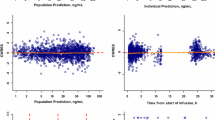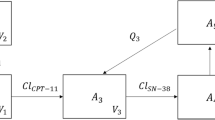Summary
To evaluate the pre-clinical pharmacokinetics of JS-38(C22H14O4N2S2F6 MW: 548), a study was conducted in Wistar rats (3 ♀, 2 ♂: 200∼250 g about 6 or 7 months). The concentration-time curve of JS-38 in rats demonstrated the pharmacokinetic (PK) characteristics of a two-compartmental model. The area under the concentration-time curve from zero to infinity (AUC 0−∞) for the low, middle and high dosage (i.e. 20, 50 and 125 mg•kg−1) amounted to 46.850±19.946, 161.101±58.877 and 312.565±187.273 mg/L•h respectively; a positive correlation was demonstrated between theAUC 0−∞ and the dosages in question (r=0.99). The average time to reach maximum concentration (T max) was 3, (RSD: 20.4% and the half-life (t 1/2) was 11.4h (RSD: 8.8%P>0.05. For the low, middle and high dosage, the maximum concentration (C max) was 4.882, 11.248, and 13.431μg•mL−1 respectively. After the administration of JS-38, except for the brain and spinal marrow, the drug distribution in the different body tissues varied, in particular in the liver, intestine and thyroid gland. A significant distribution of JS-38 was detected in cancerous tissues, and its concentrations demonstrated a tendency increase over time. There was a certain degree of distribution in the bone marrow. The urine samples showed that JS-38 nearly was practically not eliminated in its original form. The amount eliminated after 72h via the bile was only 1.03±0.1% of the administered dose. In the rat model, most of the JS-38 in its original form (53.58±22.28%) was excreted via the feces. When the intragastric administration of doses of 20, 50 and 125 mg•kg−1 was compared with i.v. administered JS-38 (1 mg•kg−1), the absolute bioavailability amounted to 22.2±9.5% 30.4±14.5% and 23.6±11.3% respectively. It was found that this compound is well absorbed in to the system and that it shows favorable PK properties. The outcome of this early pre-clinical study indicates that JS-38 is a promising drug candidate for further development.
Similar content being viewed by others
References
Akita H., Doki Y., Miyata H., Hirao T., et al. (2006): Clinical significance of the second cycle response to cisplatin-based chemotherapy as preoperative treatment for esophageal squamous cell carcinoma. J. Surg. Oncol., 93, 401–409.
Yazici Y. (2006): Methotrexate induced pancytopenia is rare and concern for it should not limit its use. Rheumatology, 45(3), 361.
Parfitt K. (1999): Martindale The Complete Drug Reference, 32nd ed.: 547. Taunton, Massachusetts. U.S.A.
Singh S.S. (2006): Preclinical pharmacokinetics: an approach towards safer and efficacious drugs. Curr. Drug Metabol., 7, 165–182.
Zhang H., Fang Y., Li Y. (2007): LC analysis of JS-38, a novel antineoplastic medicine, in the plasma, urine, bile, feces, and other tissues of rats. Chromatographia, 68, 409–414.
Beumer J.H., Beijnen J.H., Schellens J.H. (2006): Mass balance studies, with a focus on anticancer drugs. Clin. Pharmacokinet., 45, 33–58.
Author information
Authors and Affiliations
Corresponding author
Rights and permissions
About this article
Cite this article
Zhang, H., Fang, Y., Li, Y. et al. The pharmacokinetics of JS-38, a novel antineoplastic drug, in rats. Eur. J. Drug Metabol. Pharmacokinet. 33, 143–148 (2008). https://doi.org/10.1007/BF03191111
Received:
Issue Date:
DOI: https://doi.org/10.1007/BF03191111




